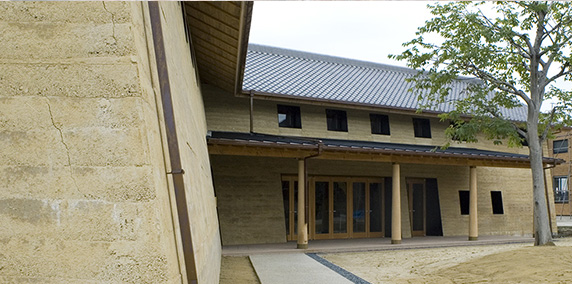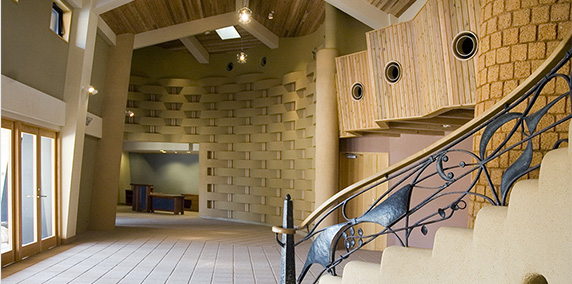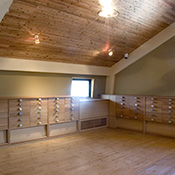Clay Works Building
The Clay Works Building is full of the charms of clay. Here we introduce the attractive features of the building.
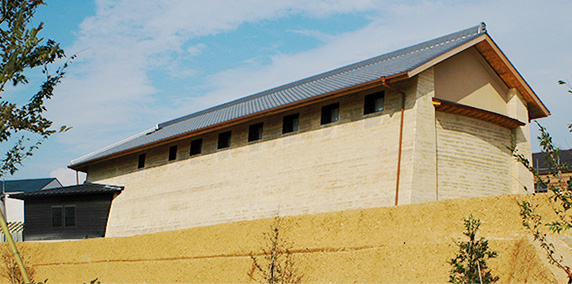
Soil is used as an ingredient for building materials and ceramic products around the world. Through generous use of soil both inside and outside the building, we have created an environment in which visitors can appreciate the various expressions that clay can portray, such as softness, roughness, and warmth.
With its rammed earth wall, hard-packed earth floor, Italian stucco, exposed aggregate finish floors, and more, the building itself is a piece of artwork, created by utilizing the skills of craftsmen. In various places in the building, we also have furniture made by blacksmiths and woodcraft artists, enhancing the atmosphere of the space created by earth. We introduce here the attractiveness of soil, a critical part of our lives, through various means. Please enjoy experiencing the potential of clay through your visit.
Building Walkthrough
- Click on the photos below for explanations of the features.
-
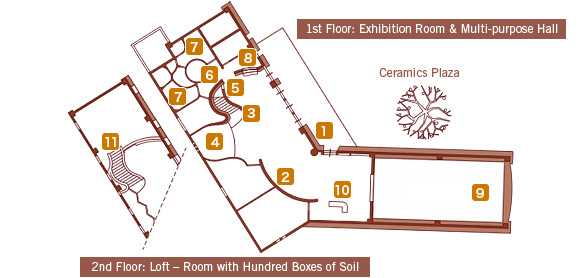
First Floor: Exhibition Room & Multi-purpose Hall
-
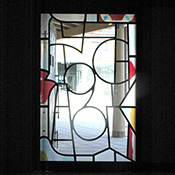
- 1Wrought Iron Works
-
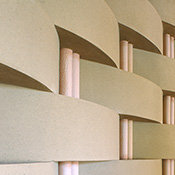
- 2The Great Tokoname Wall
-
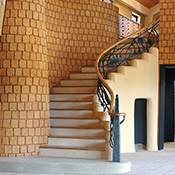
- 3Sun-Dried Brick Wall
-
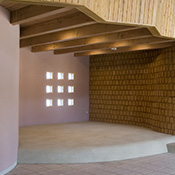
- 4Small Raised Floor
-
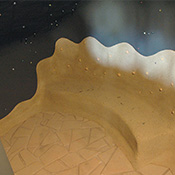
- 5Understairs Space
-
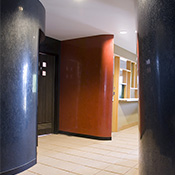
- 6Polished Walls
-
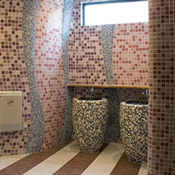
- 7Lavatories
-
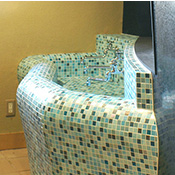
- 8Sink
-
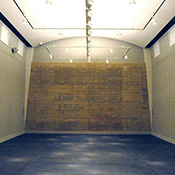
- 9Exhibition Room
-
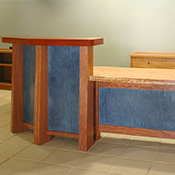
- 10Reception Desk
Second Floor: Loft - Room with Hundred Boxes of Soil
Wrought Iron Works
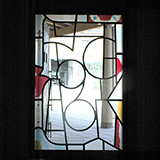
- 【Entrance】 In the entrance door, we have a wrought iron insert with stained glass, depicting the scenery of Tokoname.
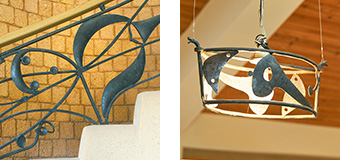
- 【Banisters and Lamp shade】 The 4.5m long banisters and the lamp shades are also creatively devised pieces of artwork by a blacksmith.
The Great Tokoname Wall
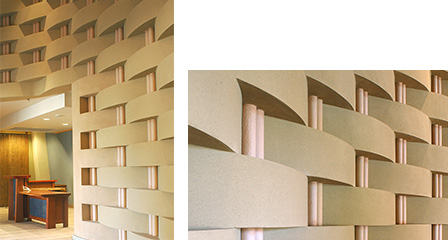
- The Great Tokoname Wall by the reception desk connects to a large space, forming a beautiful curve. The dynamic use of curves and angles gives depth to each arc, made possible by highly proficient work of plasterers. The poles between the arcs are made with clay from Utsumi in Chita Peninsula, the same clay that architect Frank Lloyd Wright used for the scratch face bricks that adorned the walls of the second main building of the Imperial Hotel.
Sun-Dried Brick Wall
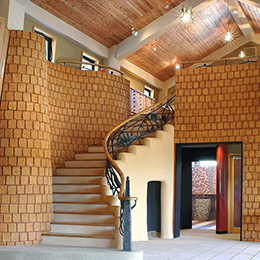
- The sun-dried brick wall around the staircase is the result of the efforts of the participants of the workshops we held in May and June of 2006. Cherishing the uniqueness of each hand-made brick, we have built a curved wall up to the second-floor loft.
Small Raised Floor
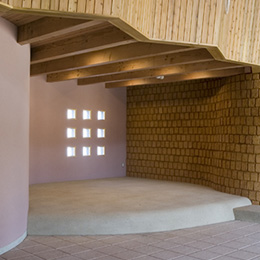
- We have prepared a small space where people can lie down and relax, paved with a mixture of soil, lime, and cement, raising the floor by approximately 30 centimeters.
Understairs Space
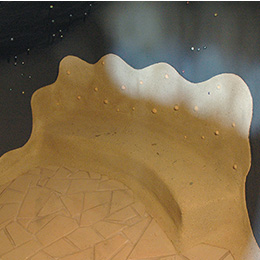
- We have created a hideaway space under the staircase with marbles positioned in the wall resembling constellation and a bench with an exposed aggregate finish which seats three children.
Polished Walls
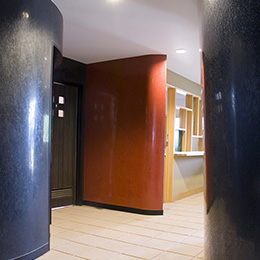
- The walls in front of the lavatories are red and black Italian stucco, patterned with granular lime and polished with a trowel.
Lavatories

- The walls and the washstands of the lavatories are fully decorated with colorful mosaic tiles, with designs imaging a forest for the men's room and water for the ladies' room.
Sink
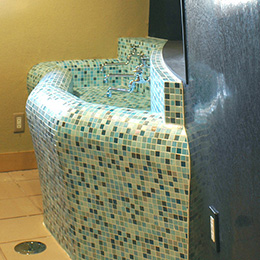
- The sink is decorated with light blue glass tiles.
Exhibition Room
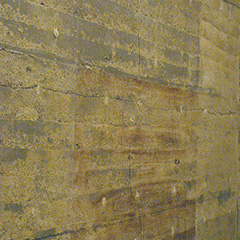
- 【Rammed Earth Wall】 Rammed Earth Wall is one of the key features of this building. It is an 80-centimeters thick mud wall with a height of approximately four meters, made by ramming down the soil placed in a 15 centimeters-wide frame and piling the compressed soil. The difference in the pressure upon compaction can be seen on the surface like a geologic stratum.
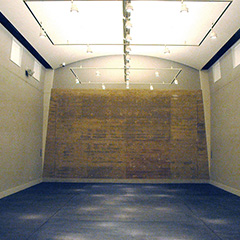
- 【Floor and Ceiling】 The floor has an exposed aggregate finish, achieved by removing the surface before it is fully hardened, exposing the pebbles. Japanese washi paper is used to cover the ceiling.
Reception Desk
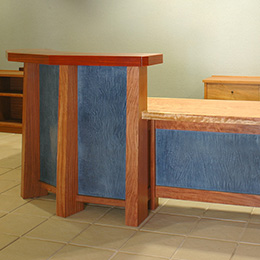
- The reception desk is a rare piece of furniture, made through a collaboration between a furniture upholsterer and a plasterer. The desktop is a single tropical wooden board, and the sides are made with navy blue Italian stucco finish.
Room with Hundred Boxes of Soil
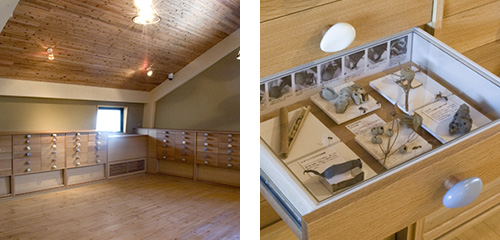
- Along the walls, we have drawer boxes lined up with stone-shaped knobs made of pottery. Each small drawer is packed with the world of soil, from various perspectives. Please come and enjoy finding your favorite box.
